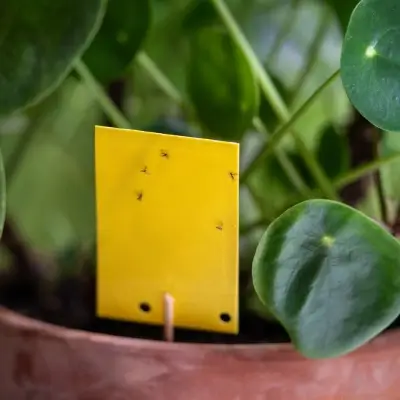
How to Get Rid of Gnats in House
Just the word “gnat” can make most North Carolina homeowners cringe. These tiny, flying pests seem to appear out of nowhere—hovering around fruit bowls, sinks, and potted plants. But where do gnats come from? If you're curious what attracts gnats, you're in the right place. In this post, our Western North Carolina pest control experts are helping you understand what attracts gnats and how to prevent future infestations in your home.
Table of Contents
What Attracts Gnats?
Gnats are primarily attracted to moisture, organic matter, and anything sweet or fermenting. They thrive in environments with where they have plenty of breeding sites and decaying materials. Here are the most common sources of attraction:
Overripe Fruits and Vegetables
Fruit bowls filled with rotting or overripe produce are one of the most common gnat hotspots. The sweet scent and decaying organic matter make perfect feeding and egg-laying sites. Keep fruits refrigerated when possible and discard spoiled produce promptly.
Moisture and Damp Soil
Excess moisture from leaky pipes, wet rags, or overwatered plants can attract gnats. Fungus gnats are especially drawn to damp soil in potted plants, where they lay eggs near the roots. Allow your soil to dry between waterings to deter them.
Sweet or Fermented Liquids
Sweet drinks, wine, vinegar, or juice residue in cups and bottles attract gnats quickly. Even a little sugar or fermentation can cause a gnat infestation near sinks or trash cans. Clean spills immediately and keep beverages in sealed containers.
Garbage and Drains
Clogged drains, garbage disposals, and dirty trash cans harbor food scraps and moisture that attract both drain flies and gnats. Rinse drains weekly with a mix of apple cider vinegar, baking soda, and boiling water to break up buildup and organic debris.
Outdoor Breeding Sites
Outside your home, standing water, compost piles, and damp mulch create ideal breeding grounds for gnats and biting midges. Regularly empty birdbaths, unclog gutters, and keep your outdoor space free of decaying vegetation to prevent more gnats from moving indoors.
Common Types of Gnats Found Indoors
Now that we've explored what attracts gnats, let's talk about the most common gnats you'll find indoors. Several small fly species are commonly mistaken for gnats. Identifying which one you have helps you choose the right solution.
Fruit Flies
These small flies, such as gall gnats, are commonly found around fruit bowls, garbage disposals, and wine glasses. Fruit flies are attracted to fermenting liquids and decaying fruit and are quick to multiply if not controlled.
Fungus Gnats
Fungus gnats thrive in damp soil and are often found near indoor plants. Their larvae feed on plant roots, damaging your greenery. Letting soil dry out and adding sticky traps around potted plants can help reduce populations.
Drain Flies
Drain flies (also called moth flies) breed in the slime buildup inside sink or shower drains. Regular cleaning and using a vinegar trap can significantly cut down on their activity.
How to Get Rid of Gnats
Now that we've explored what attracts gnats, let's discuss how to get rid of those pesky insects. If you’re dealing with an ongoing gnat problem, you can take these proven steps to eliminate them and keep them from coming back.
1. Remove Attractants
Clean up any spills or food residue and discard old produce. Empty trash cans frequently and wipe them down with disinfectant. Keep drains clear and store food in airtight containers.
2. Use Vinegar or Fruit Traps
Create a simple DIY gnat trap by mixing apple cider vinegar and a few drops of dish soap in a small bowl. Cover it with plastic wrap and poke tiny holes so gnats can enter but not escape. The vinegar’s sweet scent lures them in, and the soap breaks the surface tension to trap them.
3. Try Sticky Traps
Sticky traps are an easy, mess-free option to trap gnats around houseplants, windows, or fruit bowls. Replace them every few weeks to maintain effectiveness and reduce gnat populations.
4. Eliminate Breeding Sites
Empty and scrub drains weekly, rinse recyclables before storing, and clean under appliances where moisture and crumbs collect. Check potted plants for excess water and clean out breeding sites like compost bins and pet dishes.
5. Use Natural Repellents
Try burning citronella candles or using essential oils such as lemon eucalyptus or lavender to repel gnats naturally. These scents mask the sweet odors that attract gnats indoors.
6. Call a Professional Pest Control Service
If home remedies don’t solve the issue, you may be dealing with a deeper gnat infestation. A professional pest control expert from A-1 can inspect your property for free, identify the species, and apply safe, targeted treatments to get rid of gnats.
How to Prevent Gnats from Coming Back
Preventing future infestations takes consistent cleaning and moisture control. Here’s how to prevent gnats from returning:

- Wipe down counters and clean drains weekly.
- Keep fruit bowls clear of overripe produce.
- Store food and drinks in sealed containers.
- Fix leaky faucets and eliminate standing water.
- Allow soil in houseplants to dry between waterings.
- Use sticky traps near windows and plants to monitor activity.
Frequently Asked Questions
What causes gnats in your house?
Gnats are attracted to food waste, moisture, and light. Common sources include kitchen drains, trash cans, compost, and houseplants. The combination of warmth and humidity indoors can make infestations worse during summer months.
What attracts gnats?
What attracts gnats in your home? Gnats are drawn to sweet scents, decaying organic matter, fruit, and damp environments. Fruit flies prefer ripened produce, while fungus gnats prefer moist soil and plant roots.
Are gnats dangerous?
While most household gnats don’t bite, they can contaminate food and spread bacteria. Some species, like biting midges or no-see-ums, can cause skin irritation with their bites.
What is the fastest way to get rid of gnats?
Set up multiple vinegar or fruit traps near problem areas and clean all drains immediately. Removing attractants while using traps is the fastest way to reduce activity.
How can I prevent future gnat infestations?
Maintain a dry, clean home environment. Clean drains, control moisture, and monitor potted plants to stop gnats before they breed. Routine visits from a pest control professional can help ensure long-term prevention.
Schedule Your FREE Gnat Inspection with A-1 Pest Control
If you’ve tried everything and still see gnats indoors, it’s time to call in the experts. A-1 Pest Control has helped North Carolina homeowners tackle gnat infestations and other small flies for decades. Our team uses safe, targeted treatments to eliminate pests and prevent future problems.
Contact us today at 828-481-9140 or fill out the form below to schedule your FREE gnat inspection and get your home pest-free again.
Schedule Your Free Inspection
Complete the form to schedule your no obligation estimate with A-1 Pest Control.
"*" indicates required fields
